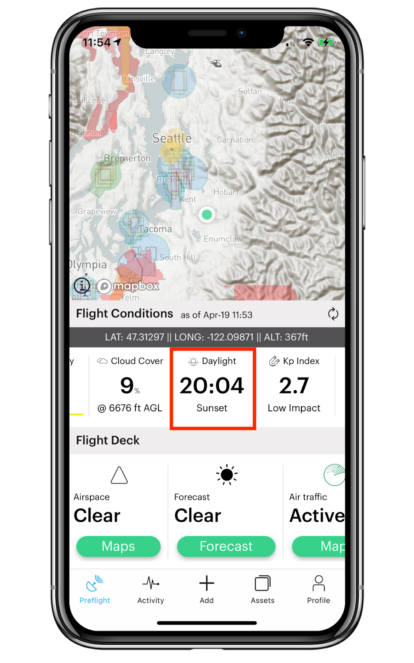With the release of LAANC V5 on the Aloft platform recently , we hope you have had a chance to update your apps and try out the new features added like LAANC at night, increased overlap and convenience of airspace authorizations and improved map designs. This version of LAANC allows Part 107 operators to apply to operate during night and civil twilight hours in controlled airspace surrounding 731 airports around the country. Read more about the other updates to the Aloft app here. Watch the video above for a tutorial on how to compliantly and safely operate your UAS in controlled and uncontrolled airspace during night or civil twilight or read more below.
Using LAANC V5 on the Aloft Platform for Night Operations in Controlled Airspace
On January 15, 2021, the FAA published its final rule for the Remote Identification of Unmanned Aircraft in the Federal Register. The final rule included changes to the existing requirements for operating UAS at night as well as UAS operations over people. Effective as of April 21st, 2021, all Part 107 pilots who have passed the new recurrent training course and exam are eligible to operate at night/ civil twilight in controlled airspace with a valid LAANC authorization.
As of August 11th, 2021, the updated version of LAANC was released allowing you to apply for a LAANC authorization during nighttime hours directly on the Aloft app.
Here are the steps you will need to take to compliantly operate your drone at night in controlled airspace:
- Have a current Part 107 certification and completed the updated recurrent online training (Read more about the new recurrent course and exam here) or have passed the Unmanned Aircraft General – Small airman knowledge test on or after April 6, 2021.
- Be equipped with operational anti-collision lights which can be seen for 3 statute miles and have a flash rate sufficient to avoid a collision.
- Have a valid LAANC authorization at or below the approved altitude in the UAS Facility Maps for your operational time.
For example, let’s say I have a project where I need to operate my drone from 6:30 – 9:30 pm PDT in Class D controlled airspace surrounding KBFI in Seattle, Washington. Before being my operations, I would be required to apply for a LAANC authorization from 6:30 pm- 9:30 pm, have a current Part 107 certification and completed the updated recurrent online training (Read more about the new recurrent course and exam here) or have passed the Unmanned Aircraft General – Small airman knowledge test on or after April 6, 2021, and be equipped with operational anti-collision lights which can be seen for 3 statute miles and have a flash rate sufficient to avoid a collision.
To avoid interruption of your operations, I recommend turning on your anti-collision light and establishing a night landing area that is illuminated by lights prior to sunset. Flying with extra caution and VOs during night operations is highly recommended as well.
How to Safely and Compliantly Operate a UAS during Civil Twilight and Night in Uncontrolled Airspace
Effective as of March 16th, 2021, all current Part 107 pilots, who also pass the new recurrent test, are eligible to operate in uncontrolled airspace at night/twilight without a waiver.
If you have never operated a UAS at night here are a few tips to ensure your operation is safe and FAA compliant:
- Remember night operations are categorized as any operation which takes place between evening and morning civil twilight. Evening civil twilight starts at sunset until 30 minutes after sunset and morning civil twilight is the period of 30 minutes prior to sunrise until sunrise. For example, sunset in my location is at 8:04 pm and sunrise is at 6:15 am so if I’d like to operate my drone anytime between 8:04 pm today and 6:15 am tomorrow, I will need to abide by the rules and regulations of night/ civil twilight operations. On the Aloft app, you can view when sunset is at any location on the map under the ‘Preflight’ info bar and then ‘Daylight’ which as you can see in the screenshot that sunset is at 8:04 pm today.
- Look 5 to 10 degrees off-center of the sUAS to help compensate for the night blind spots (the loss of sharpness, color, depth perception, and judgment of size in the center of your field of vision at night).
- Avoid looking at bright lights after adapting to darkness
- It is strongly recommended especially if you are new to night operations, to designate one or more visual observers (VOs) to scan for other aircraft or obstacles during your operation.
- Establish a night landing area that is illuminated by lights.
- Immediately land the sUAS if you cannot determine its location relative to another aircraft.
- Always make sure your anti-collision light is on and visible up to 3 miles away to maintain FAA compliance and aid in the visibility of the aircraft before take-off. There are many companies that sell after-market lighting solutions for popular drone brands. One brand with a good reputation is LumeCube.
We hope you find this information useful and best of luck in your night operations. Feel free to contact our team with any questions at support@aloft.ai.

Erica Cooley
Erica Cooley is Aloft’s Head of Community, she’s responsible for connecting with the expanding drone community to provide educational opportunities on how to leverage technology to fly with compliance and safety. Erica is an FAA-certified Part 107 Remote Pilot since 2017. Her passion for gender and diversity inclusion in the UAS industry is demonstrated as a proud member of Women and Drones & a brand ambassador for Women Who Drone. She is also an FAA Safety Team Representative in the Seattle, WA area. Erica received her BA from the University of Puget Sound in Communication Studies.



